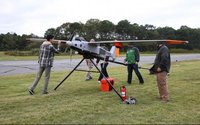 A major carrier
now supports aerial devices connected to its 4G LTE network and another may be close behind.
A major carrier
now supports aerial devices connected to its 4G LTE network and another may be close behind.
Verizon, in collaboration with American Aerospace Technologies (AATI), just completed a 4G LTE
network-connected UAS (Unmanned Aircraft System) trial in Virginia.
The trial used an unmanned plane from AATI with a wingspan of 17 feet and was designed to test connectivity between aerial
platforms and Verizon’s network.
The successful test is a first step in extending mobile networks into the sky, demonstrating how Internet of Things with cellular services can be used in
the air.
"This latest trial demonstrated how emerging technology combined with wireless networks can improve safety and security," Mike Haberman, vice president of network operations at
Verizon said in a statement.
advertisement
advertisement
"A nationwide reliable 4G LTE network is the foundation for the future of mobile IoT in the air."
The goal of Verizon’s Airborne LTE Operations
initiative, which was created in 2014, is to drive widespread adoption of 4G LTE-connected UAV (unmanned aerial vehicles) and UAS, according to Verizon.
With successful completion of the
trial, Verizon has determined that part of its 4G LTE network is now safe to use for in-flight wireless connectivity.
As a result, device manufacturers can now submit devices to be certified
for aerial connectivity the same way many have been doing for ground-based systems through Verizon’s Open Development program.
The pursuit of 4G LTE connectivity in the sky is not
limited to Verizon, however. AT&T has a similar initiative and recently teamed up
with Qualcomm for network-connected drone trials.
In that initiative, drones connected to the network will bring data-collection value to the Internet of Things, but could have a larger
impact at scale, according to Matt Walsh, director of business development for UAS and IoT solutions at AT&T.
“Like other connected products, drones will be able to collect
information from its environment through sensors,” Walsh told the IoT Daily.
AT&T also just started offering prepaid IoT data plans for developers to bring connectivity to devices at
an early stage.
“Making data plans available for developers and innovators lowers the barrier to entry,” Chris Penrose, senior vice president of IoT solutions at AT&T said in a
statement.
“It lets smaller players, used to working at the speed of innovation, get their products off the ground and in the hands of customers quickly.”
One of the
ultimate use cases for connecting aerial vehicles to the broader network would be for remote inspection of infrastructure. This connectivity could enable engineers to access near-real time data from a
UAS flying over a pipeline, such as they did in the Verizon trial, remotely from anywhere that has 4G LTE coverage, according to AATI.
Verizon also plans to launch new services next year on
its ThingSpace platform designed to help businesses and developers manage connected aerial systems, including analytics capabilities.
Verizon and AATI plan to explore using network
connectivity for long-range beyond-line-of-sight control of UAS when FAA regulations allow such operation.